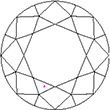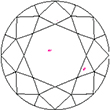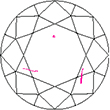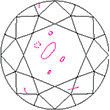Diamond Clarity
Simply stated, clarity is a measure of the tiny imperfections found in most every diamond.
A flawless diamond with little to no imperfections is often desired due to its rarity, but they are also the most costly. Therefore, it is important to keep in mind that it is very common for diamonds to be formed with slight imperfections.
These imperfections are known as "inclusions" and usually occur during the diamond's crystallization period within the earth, or from the stresses of mining and processing. Inclusions are anything from tiny white points to dark dots, cracks or scratches. The fewer inclusions, the more valuable a stone is. Clarity is evaluated using a 10‐power magnification. This means that the object viewed appears 10 times its actual size. The diamond grader examines the clarity characteristics with respect to the nature and number of characteristics, as well as their size, color and position. The clarity grade assigned reflects the degree of visibility of the characteristics.
The GIA Diamond Clarity Grade scale has five main categories of clarity characteristics with 11 grades in all.
The FL Grade (Flawless)
The term FL or flawless is used for diamonds in which a qualified observer, under favorable lighting conditions, cannot find internal characteristics and/or faults by thorough examination with a 10X loupe.
The IF Grade (Internally Flawless)
A diamond which has no internal characteristics but which, due to minor finish faults, is not flawless and therefore cannot be designated FL or flawless, may be called IF or internally flawless provided the finish faults are so minute that they can be removed by a gentle polishing with only an insignificant loss of weight.
The VVS Grades (Very, Very Small Inclusions)
The term VVS is used for diamonds with internal characteristics very, very difficult for a qualified observer to find under observation conditions as described. Further, there may only be insignificant finish faults.
The VS Grades (Very Small Inclusions)
The term VS is used for diamonds in which it is difficult for a qualified observer, under observation conditions as described, to find either a few somewhat larger internal characteristics or several very small ones.
The SI Grades (Small Inclusions)
The term SI is used for diamonds in which a qualified observer may, without difficulty, under observation conditions as described, find internal characteristics. Further, there may only occur single finish faults of an insignificant kind.
The I Grades (Imperfect)
The term I or imperfect is used for diamonds in which a qualified observer, with the naked eye, can see internal characteristics and/or in which such major faults occur, which substantially reduce the value of the stone.
Only about 2% of the world's diamonds are actually flawless. Most retail stores carry VVS as their highest grade. VS or SI are considered by most to be "fine quality" diamonds.
Types of Flaws
There are two type of flaws that a diamond can have – external and internal. External refers to flaws that may be visible on the outside of the diamond. Internal, of course, refers to flaws that may be visible on the inside of the diamond. When looking at a diamond through a loupe, your Jewelry Consultant may point out certain flaws. These flaws are essentially the diamond's fingerprint and may include:
| External Flaws |
Internal Flaws |
| Natural – unpolished surface; the original 'skin' of rough diamond |
Included – inclusions within diamond |
Cleavage or feather – inclusion along atomic grain |
Carbon spot – included crystal |
| Pit – small indentation on a flat surface |
Grain/twinning – irregularity in crystal |
| Fracture – irregular shaped break |
Pinpoint – small included crystal (appears white) |
| Cavity – a opening on the surface |
Cloud – group of pinpoints |
| Nick – Minor surface chip |
Internal grain line – visible part of internal grain structure |
| Scratch – small groove (can be due to wear and tear) |
Bearded or feathered girdle – minute to small hairline fracture extending from girdle into stone |
| Chip – Broken along eternal edge |
|
| Laser drill hole – clarity enhancements to remove or reduce the appearance of inclusions. |
|
The clarity grade of a diamond not only affects the value and price, but can also be a good indication of the diamond's vulnerability. Heavily included diamonds can be prone to breakage.




 They will be on video but won't see you.
They will be on video but won't see you. Make sure to enable your mic if prompted.
Make sure to enable your mic if prompted. Language:
Language:




